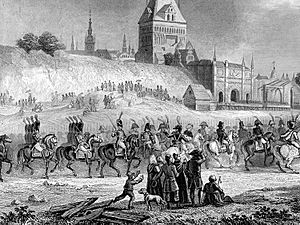Battle of Heilsberg facts for kids
Quick facts for kids Battle of Heilsberg |
|||||||
|---|---|---|---|---|---|---|---|
| Part of the War of the Fourth Coalition | |||||||
 Battle of Heilsberg. Etching by unknown artist. |
|||||||
|
|||||||
| Belligerents | |||||||
| Commanders and leaders | |||||||
| Strength | |||||||
| 50,000–64,500 overall ~30,000 engaged |
90,000 overall ~53,000 engaged |
||||||
| Casualties and losses | |||||||
|
|
||||||
The Battle of Heilsberg was a major fight during the Napoleonic Wars. It happened on June 10, 1807. This battle was part of a bigger conflict called the War of the Fourth Coalition.
What Happened at Heilsberg?
The battle took place near a town called Lidzbark Warmiński (which was known as Heilsberg back then). It was fought between the French army, led by Emperor Napoleon, and the combined forces of Russia and Prussia. The Russian army was commanded by General Bennigsen.
Before the Battle: Danzig Falls
Before Heilsberg, a long fight called the Siege of Danzig ended. On May 24, 1807, the city of Danzig (now Gdańsk) surrendered to the French. This victory freed up French troops. Napoleon wanted to attack the Russian army.
Ney's Retreat and Bennigsen's Plan
A few days later, on June 2, the Russian General Bennigsen tried to surprise a French army group. This group was led by Marshal Ney. Ney's soldiers were badly outnumbered. They were 17,000 against 63,000 Russians.
Ney fought a tough battle to escape. He lost some supplies and men. But he managed to get most of his soldiers to safety. This fight happened at the Battle of Guttstadt-Deppen on June 5 and 6.
Armies Gather at Heilsberg
Napoleon quickly ordered his large army to move. He had about 190,000 soldiers. The Russian and Prussian forces had about 115,000 men. General Bennigsen knew the French were coming. He told his troops to go back to Heilsberg.
The Russian army set up strong defenses around the town. Heilsberg was located on the Łyna River. This river helped protect their positions.
The Battle Begins
On June 10, the French army attacked. Marshal Murat led the first French attacks. Later, Napoleon himself arrived and took charge.
Tough Russian Defenses
The Russians had spent months preparing their defenses. They used the natural landscape to their advantage.
Geography and Terrain
The battle was fought along the Łyna River. A strong Teutonic Castle was a key point. The Russians controlled this castle. The land around the castle went uphill from the river. This made it hard for the French to attack. The castle also had strong walls and bridges.
Weather Challenges
The weather was also a problem for the French. It was very hot and humid during the day. Soldiers carried heavy gear. At night, it became damp and cold. This made it hard for them to rest.
French Attacks and Russian Resistance
General Bennigsen had been tricked into retreating. He thought the French had more soldiers than they did. But once at Heilsberg, his army was well-protected.
Napoleon had a choice. He could attack the strong Russian defenses head-on. Or he could try to go around them. He chose to attack directly. He also sent some troops to cut off Russian supplies.
Murat's Charge and Soult's Attack
Marshal Murat's cavalry led the first big attack. But it didn't go well. Meanwhile, other French marshals, Mortier and Davout, attacked from another side.
The French infantry, led by Marshal Soult, also attacked. The Russians, led by Prince Bagration, fought hard. They managed to hold back the French.
Napoleon Joins the Fight
Around 6 PM, Napoleon arrived with more troops. He ordered General Legrand to attack a main Russian fort. The French managed to get inside the fort.
But General Gorchakov led a strong Russian counter-attack. They pushed the French out of the fort. Even with more French troops arriving, their attacks failed.
Artillery Fire and Nightfall
The fighting was very intense. Both sides fired many cannons. The battle continued until it got dark. The French tried one more time to take the fort. But they were forced back. This last attack cost the French about 3,000 soldiers.
After the Battle
General Bennigsen became ill during the battle. General Gorchakov took over command. The battle ended in a tactical draw. Neither side won a clear victory.
On June 11, both armies agreed to a short truce. This was mainly to help the wounded soldiers. Many soldiers from both sides were hurt or killed. The French lost about 12,000 men. The Russians also had many casualties.
When Napoleon entered the Russian positions the next day, they were empty. The Russians had moved all their troops and most of their wounded during the night.
Four days later, the decisive Battle of Friedland happened. This battle ended the War of the Fourth Coalition.

